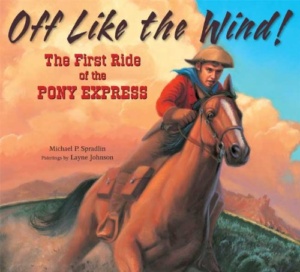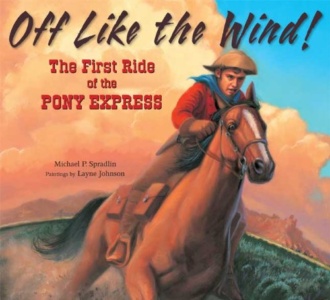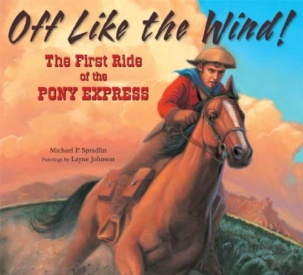Off Like the Wind: The First Ride of The Pony Express
A book for Kids
Travel with the first Pony Express riders through the dramatic and dangerous Wild West in a celebration of America’s finest frontiersmen!
In 1860, the first Pony Express rider set out on a trail from Missouri to California. With him, he carried a special delivery ~ the first mail ever carried by hand to the West. Over the next eleven days, he and many other riders would endure harsh weather, dangerous animals, and more, but nothing would diminish their unflagging determination and courage.
Meticulously researched and gorgeously illustrated, Michael P. Spradlin and Layne Johnson’s Off Like the Wind! brings to life an adventurous journey, full of suspense and excitement, that celebrates America’s can-do attitude and pioneering spirit.pny
Read an Excerpt
Extras
Writing & Illustrating Off Like the Wind
I always say that writing a picture book is a much different exercise from writing a novel. First of all you have to think of telling the story visually. In a novel, the story is internal, between you and the reader, and is limited only by your imaginations. With a picture book, you have to write it in a way that gives another artist the ability to tell the story in pictures.
A picture book (or as I like to call them word books!) is a collaboration much different from a novel. While you work with an editor on a novel to revise, craft and shape your story, with an illustrated book, you give your words over to an artist. Unless you are talented enough to do the illustrations yourself, which is not possible in my case as I cannot draw a straight line.
I've been very fortunate in my picture book career. Talented artists have taken my stories and turned them into stunning images that together with the words make something greater than the whole. My publisher at Walker & Company chose Layne Johnson to illustrate Off Like the Wind! When I heard the news, I was thrilled. I had admired his work from afar for many years. And when I learned they had selected Layne I was doubly delighted for another specific reason. You see, I've found that some illustrators have a little difficulty when it comes to rendering horses on the page. And since this was a book about the Pony Express, horses were an essential part of the story. But I knew Layne would draw beautiful horses as I was already a fan of his beautiful book Where Horses Run Free. Guy knows his nags.
I often tell students that artists working on a picture book, especially one with a historical setting, will do as much research as the writer. It was certainly true in Layne's case. He was a wonder, digging into the history of the Pony, asking me lots of questions, requesting materials and photos I had taken from my visits to St. Joseph and so on. One of the big challenges in researching this book is that so much of the source material is missing or questionable in veracity. The actual locations of stations, the true identities of men who did and didn't ride for the service were just some of the obstacles we had to overcome. And Layne proved to be a meticulous researcher even finding a couple of sources and confirmations of details I hadn't been able to uncover.
But for me the best part of working with an illustrator is when you get the chance to meet them and get to know them a little bit. And last year at the Texas Library Association I got to meet Layne in person and actually watch him work on a painting right on the convention floor! Unbelievable! I can't write with the slightest little distraction and here he was painting away in the middle of a major convention. Amazing. Not only did he prove to be a talented artist, he's also a darn nice guy. And after spending some time with him, I feel like a made a lifelong friend.
I call that a win, win.
Download the Reading Guide for Off Like the Wind! The First Ride of the Pony Express
A Reading Guide for Off Like the Wind
 This 4+ page download is a great resource! An interview with Mike, some info about the illustrator, questions for readers to consider and discuss, and a list of projects that span the curriculum in addition to Reading: Writing, Music, History, Math, and Art.
This 4+ page download is a great resource! An interview with Mike, some info about the illustrator, questions for readers to consider and discuss, and a list of projects that span the curriculum in addition to Reading: Writing, Music, History, Math, and Art.
The Guide for Off Like the Wind was created by was created by Tracie Vaughn Zimmer, a reading specialist and children’s author.
Reviews
Well researched with a bibliography, suggestions for further reading and related web sites, this book on the Pony Express is ideal for not just pleasure reading but for also doing the initial work for a school report. For families who might be vacationing along the route of the Pony Express, here's an excellent resource for heightening your child's interest in the journey.
— Bob Walch, BookLoons Reviews
Spradlin narrates the story as a timeline, following the riders through the geography of the route during the eleven day trip. Layne Johnson's riders, gallop, from left to right across two page spreads. The action often moves towards the reader as if it would burst out of the book. Stampeding buffalo thunder straight on. Johnson's landscape and charging horses bring the artwork of Charles Russell, Frederic Remington and John Ford movie westerns to mind.
— BookMoot
A good introduction for budding fans of the Old West. Stimulating.
— Booklist
The romance of the Pony Express is part of the history of the West, but the reality is much more difficult to track down. According to author Spradlin, little is known about the riders outside of the first landmark ride that began on April 3, 1860. On that date Johnny Fry left St. Joseph, Missouri, for Sacramento, California, with a pouch of eighty-five pieces of mail. Eleven days later Billy Hamilton was greeted in the streets of Sacramento by cheering crowds who heard about the riders and gathered to witness history. This picture book follows the route of the riders day by day as they move Westward, giving readers a sense of what life would have been like for the young men who rode the ponies for the seven months that the Express was in business. More than anything else it is that one statistic that should be remembered; the Pony Express began in April, 1860, and completed its last business on November 21, 1861. This book is well organized and well researched, providing historical details and dispelling romantic suppositions. In addition to an insightful "Author's Note," there is a listing of other resources that can be used for further research. This is a terrific resource for both elementary and middle school libraries.
— Janis Flint-Ferguson, Children's Literature
Author Michael Spradlin highlights a short-lived but legendary piece of American history in his exciting and beautifully illustrated (with paintings by Layne Johnson), Off Like the Wind. With a brief opening explanation of how the Pony Express came to be (through the planning of three businessmen), Off Like the Wind then unfolds in play-by-play fashion as Spradlin follows the first riders cross county on their unprecedented journey. As he explains in a final note, whenever possible he used real names and dates/locations and real heroes soon emerge. Spradlin also used more general aspects of the riders' cumulative history to show encounters with a buffalo stampede, American Indians, wolves and inclement weather. There is no gratuitous violence here however, the final note explains that documented incidents between the riders and wildlife did occur and the Pah Ute raid against the Williams Station, a stopping point for the Express riders, did happen on May 7, 1860. So as dynamic as the story is presented, it is also historically accurate which gives it that much more power. The Pony Express is a perennially popular subject and Spradlin balances excitement and truth perfectly. Johnson's dark, dynamic paintings are a great complement, giving this story the level of significance it so richly deserves. Legends are all well and good but when the facts are this exceptional, we do well to place them in such capable hands and let them speak for themselves.
— Eclectica Magazine
In an age where e-mail can be delivered in a click of a button, it's important for children to learn the history of the postal system in the U.S., beginning with the Pony Express. The book outlines the 11-day journey of the mail between Missouri and Sacramento, highlighting the many challenges, hardships and adventures the riders faced while making the crossing. Told in a clear, easy-to-read narrative, the educational story would make a great addition to any classroom.
— Inland Empire Famiy Magazine
In this rousing, as-historically-accurate-as-possible recreation of the Pony Express’s first ride, Spradlin introduces readers to the crazy-wild brainchild of three businessmen to expedite mail over the near-2,000 miles from St. Joseph, Mo., to Sacramento, Calif. Accompanied by Johnson’s artwork, which has the energy of rolling thunder and the colors of a sunset, and with an engaging sense of drama and urgency, the author follows the riders over the varied landscapes they covered, through the heavy weather they encountered and past the occasional hostile reception they received from Native Americans (though his bell-clear author’s note clarifies that hostilities were rare). When he can introduce factual material—the names of riders, the number and character of station stops, the price of $5 for ½ ounce—he does so with a light hand to keep the pedagogy at a distance. For all its iconic status, the Pony Express lasted for only a year and a half before the transcontinental telegraph drew a sleeve across its windpipe, but it was an inventive enterprise full of bodacious frontier spirit, which this book plays to the hilt.
— Kirkus Reviews
This colorful and accessible picture book recounts the day-to-day adventures of Pony Express riders on the first transcontinental mail delivery system, from St. Joseph, MO, to Sacramento, CA. The book opens with a map of the overland route, a time line of major events in the Express’s short-lived history (1860-1861), and a quote from Mark Twain’s Roughing It. On the unprecedented journey, which took roughly 11 days, riders faced extremes in weather, buffalo stampedes, wolves, and encounters with Native tribes. The straightforward text in combination with the larger-than-life panoramic oil spreads capture the romance, excitement, and danger that riders experienced along the trail. An author’s note explains that truth and legend are often intertwined when researching the Pony Express due to the destruction of records upon the cessation of service. Balancing the right amount of information with lively narrative, this book could easily be used in a history unit or as a general interest title.
— School Library Journal
Spradlin describes, day by day, the first eleven year run of the Pony Express, starting on April 3, 1860. The enterprise required planning, stamina, bravery and multiple skills, all of which, the detailed oil illustrations show in darkish hues. After a brief introduction, the text uses present tense to describe the daily challenges of the riders.
— The Horn Book Guide
Awards
Off Like The Wind! The First Ride of The Pony Express was named on the Bank Street College of Education Best Books for 2010 List. In choosing books for the annual list, committee members consider literary quality and excellence of presentation as well as the potential emotional impact of the books on young readers. Other criteria include credibility of characterization and plot, authenticity of time and place, age suitability, positive treatment of ethnic and religious differences, and the absence of stereotypes.
 Off Like The Wind! The First Ride of The Pony Express won the 2011 Best Juvenile Book Western Heritage Award from The National Cowboy Hall Of Fame & Museum, based in Oklahoma City! (Linking to the previous winners is a bit involved: click here, then enter “2011” in the year field.)
Off Like The Wind! The First Ride of The Pony Express won the 2011 Best Juvenile Book Western Heritage Award from The National Cowboy Hall Of Fame & Museum, based in Oklahoma City! (Linking to the previous winners is a bit involved: click here, then enter “2011” in the year field.)
The National Council of Social Studies, in conjunction with The Children's Book Council, placed Off Like The Wind! The First Ride of The Pony Express on the Best Books List for 2011 — Click on notable_2011, scroll to the History Section. Off Like The Wind! is on page 9.
Enjoy an Excerpt
↓ Jump to Ordering Options
Day 7: April 9, 1860
Sportsman’s Hall Station
Sierra Nevada
Sportsman’s Hall Station is another home station along the trail. Here is where the first eastbound rider, Billy Hamilton, waits for the westbound mochila. Billy is the first rider to head east from Sacramento, and he will return there with the westbound mail. He is an experienced horseman and will need every bit of his skill to make it through this part of the trail through the high mountains of the Sierra Nevada range. When he arrives at Sportsman’s Hall, he is relieved by rider Warren Upson.
Even in the springtime, the snow in the mountains is still deep. Because blizzards happen frequently, and sometimes without warning, it is easy to become lost in the blinding snow that sometimes drifts over twenty feet high. A few miles out of Sportsman’s Hall, a snowstorm whips up and Upson is forced to dismount, leading his horse through the cold and blinding snow on foot. It takes him nearly a full day to arrive at the next station, which can usually be reached in a few hours on horseback.
Back in St. Joseph, Johnny Fry rides into town with the first eastbound mail to have made the trip all the way from California. His arrival causes a great celebration. Bands play, cannons fire, and people cheer throughout the city. From there, the mail is put on a train headed east. Many people had refused to believe that the Pony Express could ever deliver the mail. But it has been done. In ten and a half days’ time, mail from the East and the West has crossed over half a continent. Three cheers for the Pony Express!
end of excerpt
Off Like the Wind: The First Ride of The Pony Express
by Michael P. Spradlin
is available in the following formats:
Digital:
- Sorry, this title is not available in digital formats
Print:
→ As an Amazon Associate I earn from qualifying purchases. I also may use affiliate links elsewhere in my site.








